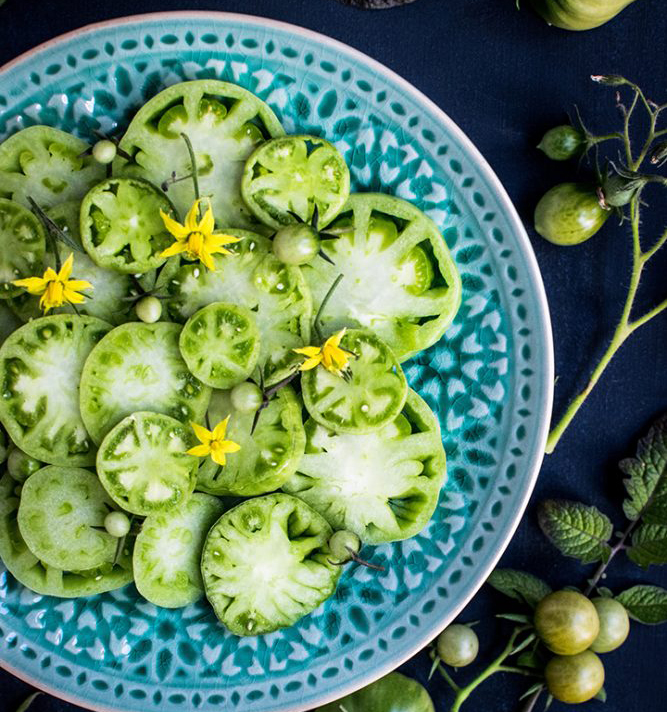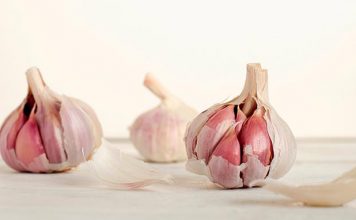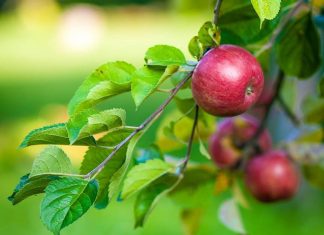 |
|
| Issue #41 • September/October, 1996 |
That gentle nip in the autumn air feels pleasant to your cheeks, but it also means that one more tomato season is about to come to an end. Although the Old Farmer’s Almanac lists frost dates for most parts of the United States, it is quite candid and adds, “The possibility of frost occurring after the spring dates and before the fall dates is 50 percent.” So at our house, when that time rolls around, we keep an ear to the radio for weather forecasts and an eye on the sky for cloud conditions. We want to protect those warm-weather-loving tomato vines as long as possible. We hate to give up those delicious vine-ripened tomatoes.
Tomato hay stacks
When we are convinced a light frost is imminent, we go into action. When we first transplant our tomatoes into the garden in the spring, we either stake them or set a cage over the plants. The method we use to lengthen the life of our vines in the fall involves the support of this stake or cage. First we pick all the small tomatoes that have no chance of ripening. Then we examine all the larger tomatoes and leave only those showing signs of having at least some blush of color. Next, we push old hay or straw up under and around and over each tomato plant, keeping the hay wrap loose and from three to four inches thick. Then we securely tie the wrap with twine around the tomato plant and its stake or cage. The stake or cage makes a good support for the “tomato hay stack.” The tomato vines stay snug and warm under their cover, and the tomatoes will ripen without any more light. Later, when we pick the ripened tomatoes, we carefully part the hay without pulling it loose, and pat it back into place until all the tomatoes are gone. Tomatoes protected in this manner ripen slowly until a very deep freeze hits, and best of all, they still have that wonderful vine-ripened taste.
The green ones
Now, about those other green tomatoes we picked before wrapping the vines. Once again, we sort the tomatoes, and we select the nicest large, full-grown ones to store.
We make sure the tomatoes are dry, then wrap them individually in newspaper. Some people don’t like to use newsprint on food, even though most newspaper ink is now made from soy bean oil. If you don’t like to use newsprint, inexpensive white paper napkins work just as well.
We store the wrapped tomatoes in shallow boxes or traysno more than two deepand set the trays in a place that does not freeze or get above about 65° F. Most green tomatoes will ripen in about four to six weeks if held at 55° to 65° with moderate humidity. To hasten ripening, I place a few unwrapped apples here and there among the tomatoes. And I check them periodically, so as to use the ripe tomatoes before they spoil.
One year, after a bumper crop of tomatoes, we sliced the last of our fresh, red tomatoes for Christmas dinner. Admittedly, tomatoes ripened this way aren’t as tasty as vine-ripened tomatoes, but they sure are a lot better than those blobs they call tomatoes and sell in the grocery store in the winter time.
Green tomato relish
Because all produce, including green tomatoes, should be freshly picked (meaning not more than 24 hours old) before starting the pickling or canning process, I immediately start processing the rest of our green tomatoes. One way to use a large amount of green tomatoes is by making those good green tomato relishes. Most green tomato relish recipes tell you to chop the vegetables and let them set overnight in a salt solution. I can quickly chop the vegetables for relish and set them aside while I prepare more green tomatoes for other recipes. Here are our favorite green tomato relish recipes.
|
||
1 quart chopped cabbage 1 quart chopped green tomatoes 2 sweet red peppers, chopped 2 sweet green peppers, chopped 2 large onions, chopped |
¼ cup salt 1½ cups vinegar, 5% acidity 1½ cups water 2 cups firmly packed brown sugar 1 teaspoon each dry mustard, turmeric, celery seed |
|
Mix chopped vegetables with salt and let stand overnight. Next morning, line a colander with cheesecloth, pour vegetable mixture into colander, let drain, then bring edges of cheesecloth up over mixture and squeeze until all liquid possible is removed. Boil vinegar, water, sugar, and spices five minutes. Add vegetable mixture. Bring to a boil. Pour into sterilized jars to within a half inch of top. Put on cap. Process in boiling water bath five minutes. Yield: six pints.Variation of Piccalilli: Use two quarts chopped green tomatoes instead of one quart cabbage and one quart green tomatoes. Also, two green sweet peppers can be substituted for the red peppers, but the relish won’t be as pretty. |
||
|
||
12 large green tomatoes 4 large sweet green peppers 4 large sweet red peppers 6 cucumbers (6 inches long) 2 large onions 6 Tablespoons salt 2 cups chopped cabbage 2 small hot peppers |
2 ½ cups sugar 3 cups vinegar, 5% acidity ½ teaspoon ground mace (or nutmeg) 1 teaspoon cinnamon 2 teaspoons ground ginger root 1 teaspoon turmeric 3 Tablespoons mustard seed 3 bay leaves |
|
Remove seeds from peppers. Put peppers, tomatoes, cucumbers, and onions through food chopper, using coarse blade. Stir salt into vegetables. Let set overnight. Next morning, line a colander with cheesecloth, pour vegetable mixture into colander, let drain, then bring sides of cheesecloth up over mixture and squeeze until all liquid possible is removed. Chop cabbage very fine. Combine all the vegetables. Add sugar, vinegar, and spices. Mix well and heat to boiling. Boil three minutes. Pack into sterilized jars to within a half inch of top. Put on cap. Process in boiling water bath five minutes. Yield: eight pints. |
||
|
||
1 peck (12 ½ pounds) green tomatoes 8 large onions 10 green bell peppers 3 Tablespoons pickling salt 6 hot peppers, seeded and chopped 1 quart vinegar, 5% acidity |
1 Tablespoon ground cinnamon 1 Tablespoon ground allspice ¼ teaspoon ground cloves 3 Tablespoons dry mustard 4 bay leaves 1 ¾ cups sugar ½ cup horseradish (optional) |
|
Remove seeds from peppers and chop with the tomatoes and onions. Stir in salt and let stand overnight. Next morning, line a colander with cheesecloth, pour mixture into colander, and let drain. Bring edges of cloth up over mixture and squeeze to remove all liquid possible. Put in a large kettle. Tie the spices in a cheesecloth bag and add to the mixture along with the vinegar and sugar. Allow to boil slowly until tender, about 15 minutes. Add horseradish, return to boil. Remove spice bag. Pack into sterilized jars within a half inch of top. Put on cap. Process in boiling water bath five minutes. Yield: 10 or 11 pints. |
||
Green tomato pickles
Next, I start making a few jars of green tomato pickles. Here are some good green tomato pickle recipes.
|
||
|
4 quarts thinly sliced green tomatoes
|
1 Tablespoon each black pepper mustard seed celery seed cloves allspice cinnamon |
|
Sprinkle ½ cup salt over vegetables, let set overnight. Next morning, drain well but do not squeeze dry. In a large kettle, mix vinegar, ¾ cup salt, and spices. Bring to boil. Add vegetables. Boil 20 minutes, pack into sterilized jars. Put on cap. Process in boiling water bath five minutes. Yields approximately eight pints. |
||
|
||
Small, firm green tomatoes Celery stalks Sweet green peppers, cut into fourths Garlic |
1 quart vinegar, 5% acidity 2 quarts water 1 cup pickling salt Dill |
|
|
Pack tomatoes into sterilized quart jars. To each jar add one stalk celery, one green pepper, and a bud of garlic. Make a brine of the vinegar, water, and salt. Boil with the dill for five minutes. Pour hot brine over vegetables to within a half inch of top of the jar. Put on cap. Process in boiling water bath 15 minutes. This amount of liquid fills six quarts. These pickles will be ready for use in four to six weeks. |
||
|
||
1 gallon green tomatoes (16 cups sliced) ¼ cup pickling salt ½ Tablespoon powdered alum 3 cups vinegar, 5% acidity 1 cup water |
4 cups sugar 1 Tablespoon mixed pickling spices ½ teaspoon ground cinnamon 1 Tablespoon celery seed ½ teaspoon ground allspice 1 Tablespoon mustard seed |
|
Sprinkle salt over sliced tomatoes and allow to stand overnight. Next morning drain well, but do not squeeze dry. Mix alum with two quarts boiling water and pour over tomatoes. Let stand 20 minutes. Drain and cover with cold water, then drain well, rinsing alum away. Tie spices in a cheesecloth bag. Combine spices with vinegar and one cup of water. Add sugar and bring to a boil. Pour solution over tomatoes, let stand overnight. On the third morning bring the pickles and the solution to a boil. Remove spice bag. Pack into sterilized jars to within a half inch of top. Put on cap. Process in boiling water bath five minutes. Yield: eight pints. |
||
|
||
No season is complete without a little bit of green tomato mincemeat for pies. |
||
3 quarts coarsely ground green tomatoes 3 quarts peeled, cored, coarsely ground apples 1 cup ground suet 1 pound seedless raisins 2 Tablespoons each grated orange and lemon rind 5 cups well-packed dark brown or raw sugar |
¾ cup vinegar ½ cup fresh lemon juice ½ cup water 1 Tablespoon ground cinnamon ¼ teaspoon ground cloves ¼ teaspoon ground allspice 2 teaspoons salt |
|
Combine all ingredients in large kettle, bring to boiling, stirring frequently. Reduce heat and simmer until dark and thick, about two and a half hours, stirring occasionally. Use a pad under kettle to help prevent scorching. Pour boiling hot into pint jars to within a half inch of top. Process in a boiling water bath 25 minutes. Makes eight pints, enough for 8 eight-inch pies. Pressure processing is not needed for this recipe because of the very long cooking time. |
||
|
||
6 pounds green tomatoes 6 pounds apples, cored and peeled 6 pounds raisins 1 pound suet 1 ½ Tablespoons salt |
6 teaspoons ground cinnamon 3 teaspoons ground cloves 3 teaspoons ground nutmeg 1 ½ cups lemon juice 3 pounds brown sugar |
|
Grind apples, tomatoes, and suet. Put into large kettle with other ingredients. Cook until dark and thick, about two and a half hours, stirring occasionally. Watch closely to prevent scorching. Pour into sterilized jars to within a half inch of top. Put on cap. Process in hot water bath 25 minutes. Yields seven quarts. |
||
Fried green tomatoes
Fried green tomatoes are ambrosia. Yes, they are fried in fat. Yes, they have a lot of calories. Forget all that. Upon occasion, some things are to be enjoyed without thinking of fat and calories. This is one of those occasions.
|
||
Slice large green tomatoes about 1/4-inch thick. Let stand in salt water (one Tablespoon salt to one quart water) four hours to overnight. Drain well. Pat dry. Dip each slice in flour. Fry in hot fat, turning once until golden brown. Serve hot. For extra flavor, add two Tablespoons bacon drippings to fat for frying. This is a good side dish or a good meat substitute with eggs for breakfast.Variation:Dip each slice of tomato in beaten egg, then into cornmeal. Fry in hot lard.Variation:Oven fry. Coat bottom of baking dish with cooking oil. Heat in oven. Layer coated tomato slices one thickness in dish. Bake 350° F. until golden brown and soft, about 25 minutes.
|
||
The brine-dill jar
This is by far our favorite. I like this recipe because I don’t have to can these pickles unless I want to. Usually after a couple of weeks, there is nothing left to can, anyway, because my family eats them up so fast. This recipe is adaptated from the one given by the late Euell Gibbons, a nationally-known author and expert on wild foods. This is an imprecise recipe, and no two brine-dill jars are alike. You use what you have on hand or can forage. The only absolutely necessary things are onions, garlic, and dill, preferably fresh, but dried or frozen is all right.
|
||
Wash well and scald a gallon-size glass jar with a wide top. Pack a layer of dill in the bottom, add several cloves of garlic, then start layering vegetables into the jar, packing dill in between each layer. I put in several layers of small green tomatoes, about ping-pong ball size. Green cherry tomatoes are especially good. Use a layer of onions somewhere in the jar. If you don’t have small boiling onions, slice larger onions. Peeled, sliced Jerusalem artichokes are good. Tender green or wax beans are good. (They are the only vegetables that must be cooked before adding to the jar. They have to be parboiled for about five minutes.) Cauliflower broken into small florets is great. Capers and a few red Tabasco peppers add a bit of dash. The white part of leeks and sweet peppers, either green or red, seeded and cut into strips, add interest.But many times, I have used only the green tomatoes flavored with the dill, onions, and garlic.Make a brine of ¾ of a cup of pickling salt to 10 cups of boiled and cooled water. Add ¼ cup cider vinegar of 5% acidity. Pour over vegetables in jar, insert a knife blade to remove air bubbles, then cover the top of the vegetables with more dill. Weigh down the top of the vegetables with something like a saucer weighted with a jar of water to keep everything below the brine, and let the jar cure at room temperature. Let the jar set about two weeks. Stand back when you open the jar: a stampeding family can be dangerous. If you want to preserve these pickles, pack into hot, sterilized jars along with more dill. Strain the brine, bring to a boil, and pour over pickles. If you need more brine, use ½ cup pickling salt, four cups of 5% vinegar, and one gallon of water, and bring to a boil. Seal. Process in boiling water bath 15 minutes, starting to count the time when the hot jars are placed in the actively boiling water.
|
||
Finally, after we’ve stored and pickled and canned all the green tomatoes we can possibly useand stand to look atwe are quite happy to dump the rest into the compost pile. We’ve found that the tomatoes compost best if we layer them in the compost pile not more than one tomato deep and separate each layer with some leaves, straw, and animal manure. Otherwise, they just sit and sog.
Ripe or green, tomatoes can be used in more ways than almost any other vegetable, which is one reason they have become the home gardener’s favorite crop.
Making pickles: containers, salt, and vinegar
When making relishes and pickles or other acidic foods, use only glass, crockware, stainless steel, or graniteware containers. Acid foods react with aluminum ware, which should not be used to soak or cook those foods in.
Use only canning and pickling salt. Do not use table salt, either the plain or iodized type. Table salt contains fillers to keep it from caking, and those fillers react with pickling acids and spices, making the pickles dark, taste off-flavor, and sometimes spoil. Canning and pickling salt can be purchased at most grocery stores and is usually located beside the canning supplies or with the salt and spices. It can be purchased in two or five pound bags and will be clearly marked.
Vinegar used in pickling should be of 5% to 6% acidity. The strength of vinegar is usually shown on the label. If the vinegar is too weak, the pickles will spoil or become soft.














